Do you smell something musty and are experiencing mold allergy symptoms? Do you suspect the presence of mold spores in your indoor air? Find out how to effectively test for mold in your house here!
If you are experiencing mold allergy symptoms and notice that your asthma attacks are getting worse, mold spores floating in the air might be the cause. Smelling something musty and damp is another definite sign of mold infestation in your home. This article aims to guide you on how to test your house for mold including your indoor air, walls, and basement properly and effectively.
Key Takeaways
- Wear protective gear, cover up, and be careful not to disturb mold spores when testing for mold yourself.
- House molds usually come in shades of green or black discolorations and have a furry or velvety texture.
- You will find mold in damp, dark, and humid areas in your home with organic matter they can feed on like basements, drywall, and others.
- DIY mold test kits are available, but professional testing and remediation will ensure accuracy and complete removal without exposing yourself further.
- Leakages and other sources of moisture are the common causes of mold growth.

Hire RPF Environmental for certified mold assessment and indoor air quality testing in Maine, New Hampshire, Massachusetts, and beyond New England. We offer high-quality environmental testing services to homeowners, businesses, organizations, and schools at prices you can afford. Contact us now!
First Step: How to Safely Prepare When Testing for Mold in Your House
It is important that you follow safety precautions before you test for mold in your home to prevent releasing more airborne spores and exposing yourself and your family. Follow the safety tips below before you handle or clean mold:
- Wear protective gear like gloves, a respirator mask, and goggles
- Cover up and avoid exposing skin (wear long-sleeve clothes, pants, and shoes)
- Avoid disturbing mold colonies as much as possible
How to Test Your House for Mold Through Proper Mold Identification: What Does Mold Look Like?
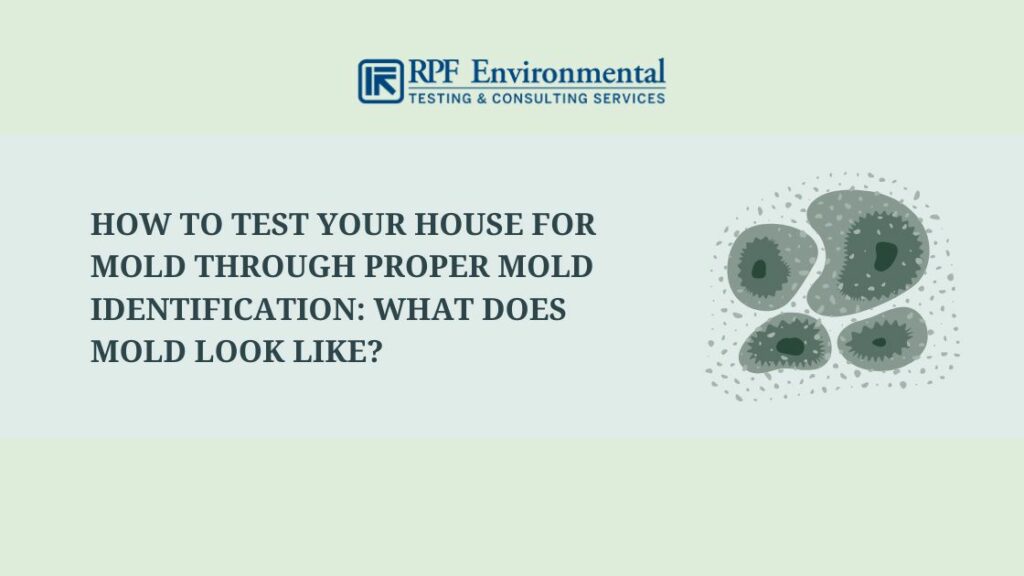
Spotting visible mold is the easiest way to detect mold in your home. Mold usually appears as discolorations or stains in green or black colors but can also come in blue, brown, orange, grey, or white. They are often velvety or furry but can also be wet and slimy and can become powdery when they dry out. (Also Read: Mold Fact: Does It Die When It Dries Out?)
Mildew, a certain kind of mold, is among the easy ways to check your home for mold infestation. Mildew starts as tiny, grey spots (but can also be yellow or white) that are fluffy or powdery. You can often find them growing on your walls, grout lines, windowsills, and other places with high moisture levels. But unlike mold, mildew only grows on surfaces and does not burrow deep into materials.
“In most cases, if visible mold growth is present, sampling is unnecessary.”
– EPA, Mold Testing or Sampling
If you have spotted visible signs of mold growth, the CDC and EPA do not recommend testing but suggest prioritizing remediation and removal instead. Only a certified professional should perform mold assessment and removal/remediation to ensure that mold is removed completely from your home. However, testing might still be necessary to identify specific sources of mold problems and help with effective removal.
Common Types of Mold Found in Homes
“You do not need to know the type of mold growing in your home, and CDC does not recommend or perform routine sampling for molds. No matter what type of mold is present, you should remove it.”
– CDC, Basic Facts About Mold and Dampness
There are many types of mold that can be found in homes, but the most common indoor molds according to the CDC are:
- Aspergillus
Aspergillus species usually come in dark colors including gray and green. They are common in walls, crawl spaces, ceilings, subfloor, and others.
- Penicillium
These are blue-green and fluffy airborne molds that grow on organic materials like wooden materials and paper.
- Cladosporium
Cladosporium can look like green, black, or yellow spots on damp surfaces, carpets, insulation, and curtains.
In addition, there are rare cases when Stachybotrys chartarum (popularly known as the toxic black mold but can come in greenish-black colors) can grow inside buildings. This type of mold can be found mostly in wood, food, and other leaky areas.
Checking if It Is Mold or Dirt/Dust
When you test for mold in your home, verify if those dark spots on your wall and other surfaces are really molds or just dirt through one of these methods:
- Dip a clean cotton swab into a diluted bleach solution and dab it on your wall. If the area brightens after a while, it is mold. Dirt/dust won’t react with bleach.
- It is mold if you smell something earthy, damp, or musty. Severe infestations will smell worse like sweaty socks or rotten meat. (Note: Ensure that the pungent smell is not caused by other sources like dirty laundry.)
- If you can wipe the spots off easily, they’re just dust particles. You can’t remove mold easily because it burrows deep into cracks.
Also Read: Mold Infestation Signs: What Does Mold in the House Smell Like
Common Areas Where Mold Can Grow: Where You Can Find Mold in Your Home?
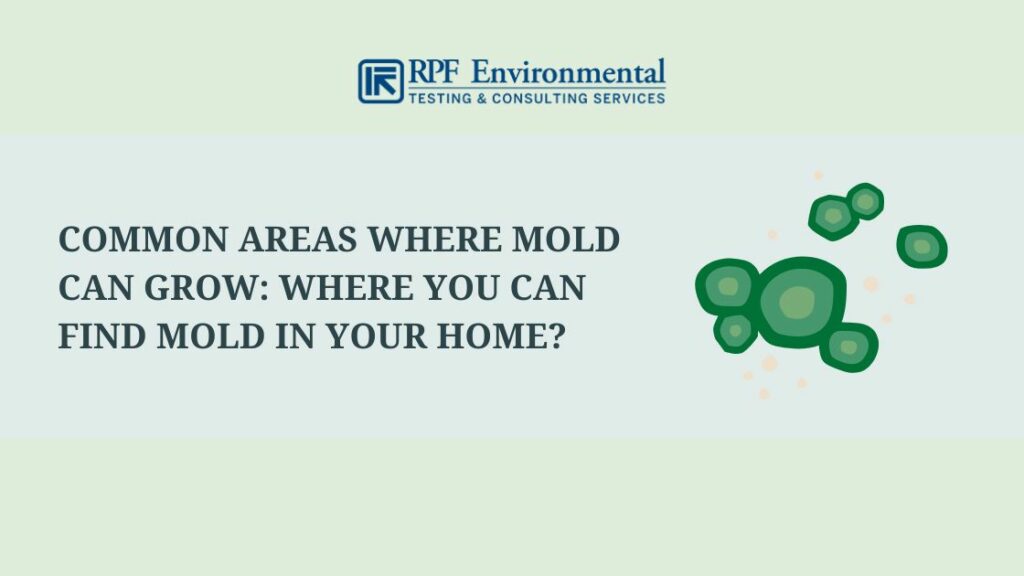
Checking the right places when testing your house for mold is important, especially if you can’t see any visible signs of mold in your house and you’ve experienced previous flooding. Mold usually grows in dark, damp, and humid areas such as your basement, walls, ceilings, floors, and around your air vents. Once mold spores in the air land on surfaces where there is moisture and organic matter that they can feed on, they will start to grow.
Check for mold in the following areas and surfaces:
- Behind your drywall
- Under your sinks
- HVAC ducts
- Crawl spaces
- Attic
- Between your furniture and walls
- Behind your appliances (e.g. refrigerators, dishwashers)
- Around plumbing pipes
- Under your carpeting
- Under stacked paper products
- Wooden furniture
- Around your windows
- Leaking roof
- Other surfaces like wallpaper, fabric, & upholstery
- Other areas exposed to water
Also Read: 17 Common Places Where You Can Find Mold in Your Home
Other Ways on How to Test Mold in Your Walls, Basement & Indoor Air
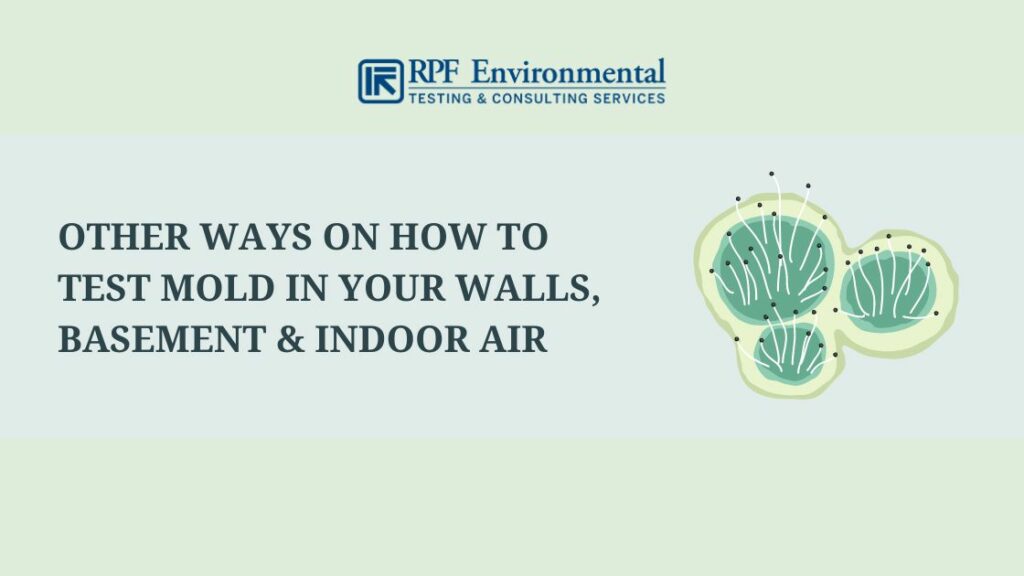
Aside from visible mold spores, looking for leaks and other sources of moisture is another way to test your home for mold. Using mold testing kits for small infestations and professional testing for severe ones are the most effective ways.
Checking for Leaks & Other Sources of Moisture
Seeing mold around your water pipes, plumbing fixtures, or ductwork may be caused by leaks or poor ductwork insulation which causes condensation. Check for leaks in your roofing too as well as improperly sealed window sills. Warping or bubbling on your walls may also indicate mold growth.
Read More Here: 11 Signs of Hidden Mold in the House and How to Find Them
Finding & Testing for Hidden Mold: How to Test for Mold Through DIY Mold Testing Kits & Professional Testing
#1 DIY Testing for Mold Using a Mold Test Kit
You can buy mold test kits at hardware stores near you or from online retailers at an affordable price. The four main types of test kits for mold include petri dishes, tape strips, swab tests, and air pumps that collect air particles to test for mold in the air. Make sure to follow the instructions on how to use the kit properly.
However, take note that not all test kits are the same and are also not guaranteed to be always accurate. Moreover, most can only detect mold in your home and won’t tell you what to do about your mold infestation problem. You will still need a professional to help you assess, remediate, and remove mold in your home effectively.
#2 Professional Mold Testing & Assessment
“Sampling for mold should be conducted by professionals who have specific experience in designing mold sampling protocols, sampling methods and interpreting results.”
– EPA, Mold Testing or Sampling
Mere visual inspection and DIY mold testing kits won’t be able to identify the extent of the infestation. They won’t also give you recommendations on how to deal with the problem in case the presence of mold has been confirmed in your house.
The best way to test for mold in your home is through professional mold testing because they can spot both visible and hidden mold in any room in your house. They can test your air for mold and can even detect the presence of toxic black mold as well as identify sources of mold infestation. Moreover, they can provide recommendations regarding mold remediation and removal which guarantees that mold won’t return to your home.
When Should You Test for Mold?
In addition, you should hire a professional mold and indoor air quality testing company if:
- You are buying a new house and want to ensure that it is mold-free
- You are experiencing moisture problems
- You can’t locate the source of the musty smell in your home
- You are experiencing respiratory problems or chronic allergy symptoms
- After performing mold remediation to ensure that mold is completely gone in your home
Best Tips on Mold Remediation & Removal: When Should You Hire a Certified Mold Remediation Company?
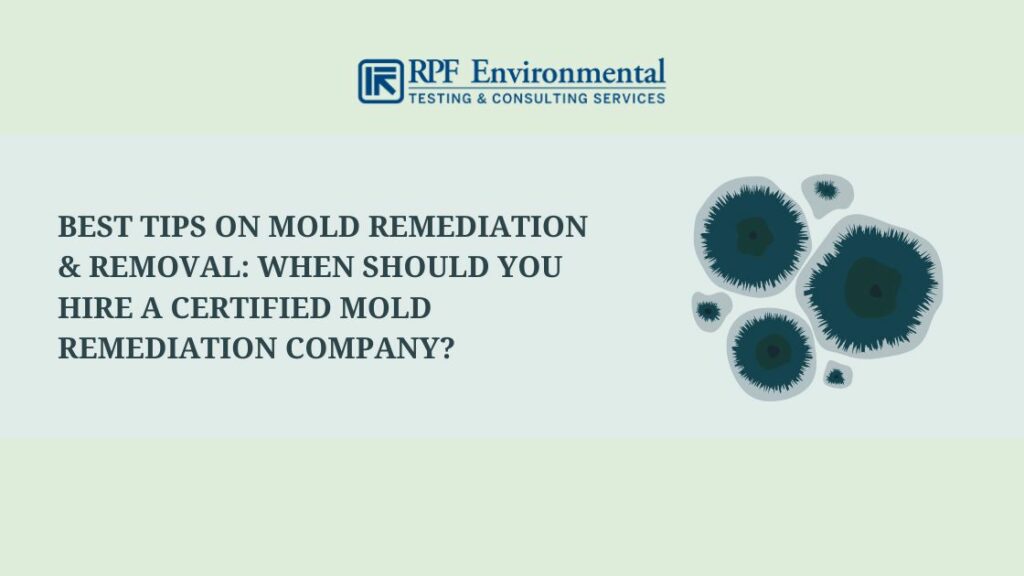
Before you try to remove mold yourself after checking your house for mold infestation, take note of the following:
- Only remove mold that is easy to remove like those growing on hard and nonporous surfaces like metal, glass, tile, and others. The infestation should also not be more than 10 square feet. Otherwise, hire a professional mold remediation company.
- Hire a professional if you have immunocompromised individuals, children, and elderly people in your home. Improper DIY removal can cause mold spores to become airborne and worsen allergies and other respiratory diseases.
- Don’t remove mold yourself if you’re unsure about the extent of the infestation, don’t have the right tools, or don’t know how to properly do it.
- Let professionals handle mold removal from enclosed areas (e.g. inside your walls), HVAC systems, and other areas that are hard to clean.
- When hiring a mold remediation professional, make sure that they have valid credentials.
- Have your home checked for mold again after remediation/removal to ensure complete removal.
- Hire a mold assessment company that is independent of any mold remediation company to avoid conflict of interest.
If you’ve confirmed that you can remove mold yourself, you can use household products, diluted bleach (1 cup in 1 gallon of water), or soap and water on hard surfaces.
Other Tips When Doing DIY Mold Removal
- Ensure that the room is properly ventilated before cleaning.
- Don’t mix bleach with household cleaners including ammonia for cleaning to avoid producing poisonous gas.
- Wear protective gear.
Also Read:
- DIY Mold Removal: When To Do It & How to Get Rid of Mold Safely in Your Home
- Mold Remediation Using Bleach: When to Use It, Why Not Use It, & Safer Alternatives
- Mold Clean-Up After Disasters: When to Use Bleach
Effective Mold Prevention Tips From the Pros
Below are a few effective ways on how to prevent and control mold in your home according to the CDC:
- Use a dehumidifier or air conditioner to keep humidity levels low (less than 50% all day).
- Vent exhaust fans and dryers outside.
- Fix leaks and other sources of moisture problems.
- Use mold-killing products to clean your bathroom.
- Use mold prevention paints.
- Avoid using carpets in your basement or bathrooms.
Other Things to Know About House Mold Testing
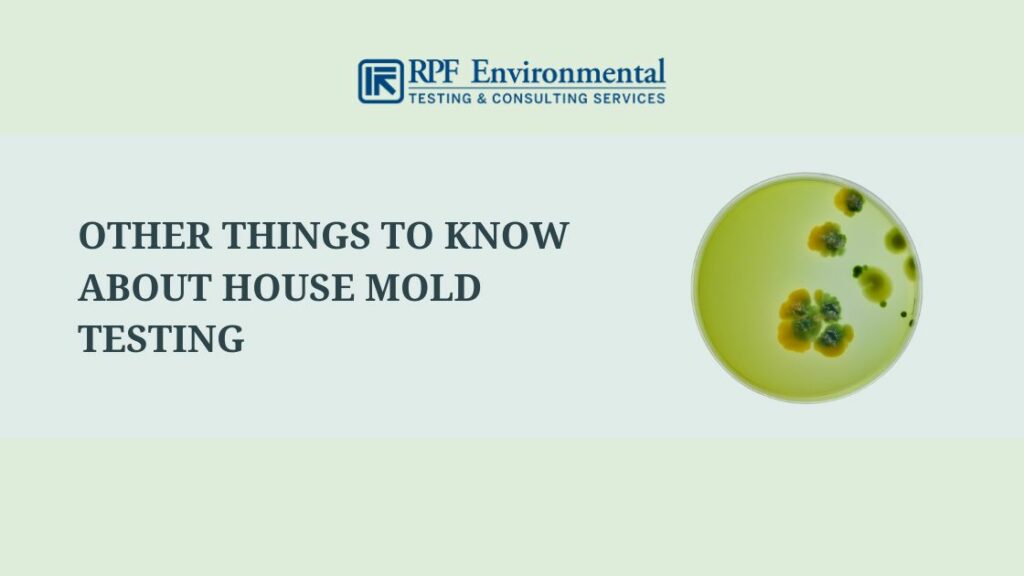
Can You Test for Mold in the Air by Yourself? Is There a Device That Can Detect Mold in the Air?
You can test for mold spores in the air by using an indoor air sampling kit that includes an air pump for sample collection. After that, you can mail the samples to a certified laboratory for analysis. However, take note that mold testing kits can be inaccurate which makes hiring a professional a better option when testing for mold spores in the air.
How Do Professionals Test for Mold Inside Walls?
To tell if mold is inside your walls, professionals will take samples from the affected area through a swab test, bulk sampling (taking a piece of your drywall), and/or air test. After sample collection, they will take the samples to a laboratory for testing.
What Should You Do if You Suspect Mold in Your Basement, Walls, or Other Parts of Your House?
Hire a certified mold testing company to help you identify all mold issues in your home. If the presence of mold has been confirmed, hire a separate mold remediation company for mold removal.
Also Read:
- Mold Fact: Does It Die When It Dries Out?
- Green Mold: Health Risks, Identification, Removal, & Prevention
- Black Mold vs. Green Mold: What Are Their Differences?
FAQs
Look for visible signs like discolorations or dark spots on surfaces, visible mold spores, warped walls, and other moisture issues. You may also smell something damp and musty as well as experience worsened allergy and asthma attacks.
Symptoms of mold sickness include stuffy nose, persistent coughing, sneezing, itchy eyes or skin, and wheezing. Individuals with existing respiratory conditions might experience more intense reactions.
Smelling something musty and not finding where it is coming from might be a sign of mold infestation. You can also use indoor air sampling kits, but professional testing is better at finding the root cause of mold in your air.
The best and most effective way of detecting mold in your house is by hiring a certified professional with the right credentials and technology. Aside from mold testing, they can also find invisible mold and sources of mold exposure in your home to help you with mold remediation/removal.
Conclusion
You can check your home for mold infestation yourself by looking for visible signs and using mold test kits. However, having a licensed mold testing company do the job for you will ensure accurate results and complete removal of mold from your home.
RPF Environmental can help you detect and test for mold in your house to identify sources of hidden mold for remediation and removal. Contact our mold and indoor air quality experts to know more!




